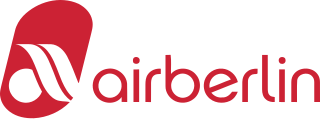
The Boeing 747 is a long-range wide-body airliner designed and manufactured by Boeing Commercial Airplanes in the United States between 1968 and 2023. After the introduction of the 707 in October 1958, Pan Am wanted a jet 2+1⁄2 times its size, to reduce its seat cost by 30%. In 1965, Joe Sutter left the 737 development program to design the 747. In April 1966, Pan Am ordered 25 Boeing 747-100 aircraft, and in late 1966, Pratt & Whitney agreed to develop the JT9D engine, a high-bypass turbofan. On September 30, 1968, the first 747 was rolled out of the custom-built Everett Plant, the world's largest building by volume. The 747's first flight took place on February 9, 1969, and the 747 was certified in December of that year. It entered service with Pan Am on January 22, 1970. The 747 was the first airplane called a "Jumbo Jet" as the first wide-body airliner.
Deutsche Lufthansa AG is the flag carrier of Germany. When combined with its subsidiaries, it ranks second in Europe for passengers carried and the world's fourth-largest airline by revenue. Lufthansa was founded in 1953 and commenced operations in April 1955.
Continental Airlines was a major airline in the United States that operated from 1934 until it merged with United Airlines in 2012. It had ownership interests and brand partnerships with several carriers.

Cathay Pacific Airways Limited (CPA), more widely known as Cathay Pacific, is the flag carrier of the Hong Kong Special Administrative Region with its head office and main hub located at Hong Kong International Airport. The airline's operations and its subsidiaries have scheduled passenger and cargo services to over 190 destinations and more than 60 countries worldwide including codeshares and joint ventures.

Singapore Airlines is the flag carrier of Singapore with its hub located at Changi Airport. A member of Star Alliance, the airline is notable for highlighting the Singapore Girl as its central figure in the corporate branding segment and not significantly changing its livery throughout its history. Widely renowned as one of the world's best carriers, the airline is ranked as a 5-star airline as well as ranked as the world's best airline by Skytrax five times. The airline operates a variety of Airbus and Boeing aircraft, namely the A350, A380, Boeing 737, Boeing 747 Freighter, Boeing 777 and Boeing 787, among others.
Swiss International Air Lines AG, stylized as SWISS, is the flag carrier of Switzerland and a subsidiary of the Lufthansa Group, as well as a Star Alliance member. It operates scheduled services in Europe and to North America, South America, Africa and Asia. Zurich Airport serves as its main hub and Geneva Airport as its secondary hub.
Virgin Australia, the trading name of Virgin Australia Airlines Pty Ltd, is an airline based in Brisbane, Australia. It is one of two active airlines to use the Virgin brand, as well as the larger by fleet size. It commenced services on 31 August 2000 as Virgin Blue, with two aircraft on a single route. It suddenly found itself as a major airline in Australia's domestic market after the collapse of Ansett Australia in September 2001. The airline has since grown to directly serve 32 cities in Australia, from hubs in Brisbane, Melbourne and Sydney.
Luxair, legally Luxair S.A., Société Luxembourgeoise de Navigation Aérienne, is a flag carrier of Luxembourg with its headquarters and hub at Luxembourg Airport. It operates scheduled services to destinations in Europe, North Africa, the Mediterranean and Middle East with additional charter and seasonal services. It is Luxembourg's only passenger-carrying airline offering regular, non-charter service.

JetBlue Airways Corporation is an American low-cost airline. It is headquartered in the Long Island City neighborhood of the New York City borough of Queens. It also maintains corporate offices in Utah and Florida.

The Boeing 747-400 is a large, long-range wide-body airliner produced by Boeing Commercial Airplanes, an advanced variant of the initial Boeing 747. The "Advanced Series 300" was announced at the September 1984 Farnborough Airshow, targeting a 10% cost reduction with more efficient engines and 1,000 nautical miles [nmi] of additional range. Northwest Airlines became the first customer with an order for 10 aircraft on October 22, 1985. The first 747-400 was rolled out on January 26, 1988, and made its maiden flight on April 29, 1988. Type certification was received on January 9, 1989, and it entered service with NWA on February 9, 1989.

Air Berlin plc & Co. Luftverkehrs KG, branded as airberlin or airberlin.com was a major German airline. At its peak, it was Germany's second-largest airline after Lufthansa, as well as Europe's tenth-largest airline in terms of passengers carried. It was headquartered in Berlin and had hubs at Berlin Tegel Airport and Düsseldorf Airport. At the time of its insolvency, it was a member of the Oneworld airline alliance, having joined in 2012.

Harmony Airways was an airline headquartered in Richmond, British Columbia, Canada, a suburb of Vancouver. It operated holiday flights from Canada to Mexico, Hawaii and Las Vegas, Nevada. Its main base was Vancouver International Airport.
Oman Air is the flag carrier of Oman. Based at Muscat International Airport in Muscat, it operates domestic and international passenger services, as well as regional air taxi and charter flights.
Austrian Airlines AG, often shortened to Austrian or AUA, is the flag carrier of Austria and a subsidiary of Lufthansa, the flag carrier of the Federal Republic of Germany. The airline is headquartered on the grounds of Vienna International Airport in Schwechat where it also maintains its hub. As of July 2016, the airline flew to six domestic and more than 120 international year-round and seasonal destinations in 55 countries and is a member of the Star Alliance.

In-flight entertainment (IFE) refers to the entertainment available to aircraft passengers during a flight. In 1936, the airship Hindenburg offered passengers a piano, lounge, dining room, smoking room, and bar during the 2+1⁄2-day flight between Europe and America. After World War II, food and drink services were offered, and movies were projected onto big screens viewable by all passengers on long flights. In 1985 the first personal audio player became available for purchase, and noise cancelling headphones were introduced in 1989. During the 1990s, the demand for better IFE was a major factor in the design of aircraft cabins. Before then, entertainment came via audio headphone sockets and airline-provided headphones providing music of various genres and the soundtrack of projected movies. Now, in most aircraft, personal IFE display screens are available at most seats, offering entertainment and flight information such as a moving map, speed, and altitude. The advent of small entertainment and communication devices also allows passengers to also use their own devices, subject to regulations to prevent them interfering with aircraft equipment.
SITAONAIR is a company that enables airline passengers to use their smart devices including mobile phones and laptops for calls, text messaging, emails and Internet browsing.

Gogo Business Aviation is a division of Gogo Inflight Internet is a provider of in-flight broadband Internet service and other connectivity services for business aircraft. It is headquartered in Broomfield, CO.

Gogo Inc. is an American provider of in-flight broadband Internet service and other connectivity services for business aircraft, headquartered in Broomfield, Colorado. Through its Gogo LLC subsidiary, Gogo previously provided in-flight WiFi to 17 airlines until the Commercial Air business was sold to Intelsat for $400 million in December 2020. According to Gogo, over 2,500 commercial aircraft and 6,600 business aircraft have been equipped with its onboard Wi-Fi services. The company is the developer of 2Ku, new in-flight satellite-based Wi-Fi technology rolled out in 2015.
AeroMobile Communications Limited is a registered mobile network operator for the aviation industry and is based in the UK. It provides technology and services that allow the safe use of passengers' own mobile phones while inflight. A subsidiary of Panasonic Avionics Corporation its services are often installed alongside Panasonic's Wi-Fi network and can be installed either at the point of aircraft manufacture or retro-fitted across both Airbus and Boeing aircraft. Panasonic Avionic's Wi-Fi network and AeroMobile's mobile phone network are complimentary services and provide passengers with a choice of inflight connectivity options.
FlyNet is an onboard communication service for Lufthansa.












